New Orleans Cuisine: Learning About Culture Through Food
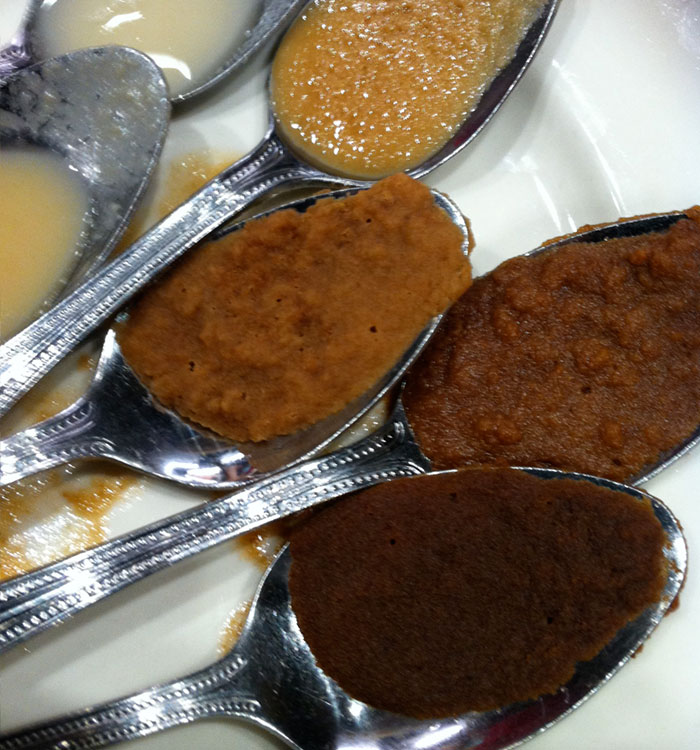
The origin of the word “restaurant” is French and dates back to the Middle Ages. It described any variety of rich bouillons made with meats, roots, vegetables, herbs and non-native ingredients brewed to “restaurer” or “restore” your health.
The best restaurant experiences have a magical restoring quality. They bolster a weary soul to liveliness or shore up serenity with their comforts and indulgences.
Such was the conversation a truly stellar hostess and passionate long-time restaurateur, JoAnn Clevenger of Upperline Restaurant in New Orleans, shared with me. While enjoying a week in New Orleans one January, I experienced several enchanting, restorative experiences. I returned with renewed energy to endure the remainder of an Ontario winter and share NOLA recipes, techniques, stories and music.
A classic and simple two-ingredient (fat and flour) staple of French cuisine, “roux” is a flavourful and thickening base for many soups, stews and sauces. You make your own “roux” if you stir flour into turkey drippings to make gravy at Christmas.
The spoons above depict roux’s white, blond, caramel, golden-brown, deep golden-brown and mahogany-brown cooking stages. The darkest spoonful illustrates when the cooking time of the roux is taken to the max carefully. The colour and subsequent nutty, tannic, dense and richly flavourful qualities that this creates permeate a traditional Southern Louisiana soup/stew called a “gumbo.”
Gumbo is hard to pin down in words, but listening to any Louisiana local describing all that is gumbo is a treat. Gumbo has mystical, historical and cross-cultural qualities that combine in a one-pot, crowd-pleasing blend of very full-flavoured, delicious local ingredients. This recipe originates in several cultures, including West African, French, Spanish, German and Choctaw (Native American).
Each gumbo is as different as the cook who creates it. Tasting a well-made gumbo (try to avoid the tourist traps) is a symphony of comfort and liveliness. Restorative? For sure!
I am excited to try making my own filé powder (also called gumbo filé), used as a secondary thickening agent in gumbo-making. Filé is made from ground sassafras tree leaves. Tree House Kitchen sits perched amongst a swath of Carolinian forest that incidentally supports more endangered and rare species than any other life zone in Canada. (Ontario is two-thirds forest!) And you can find the sassafras tree here!
“All praise for cooks and storytellers.” JoAnn Clevenger has written this inscription into one of her favourite New Orleans cookbooks and handed it to me as a generous gift—and it is so true!
Learning about New Orleans’s history, present and future through the storytelling of locals (and they are fantastic storytellers) and reading the stories of a place that good restaurant menus hint at (by describing seasonal ingredient availability, styles and eras of cooking, ingredient lists and complexities/simplicities of recipes) is purely good fun! Turning these experiences into sensory ones by taste-testing is pure happiness! It steeps you in more of an insider’s knowledge, off the beaten tourist-trap path.
As a chef, it is no surprise that my best travelling experiences revolve around eating and studying food. New Orleans has so many good restaurants, fantastic owners and talented chefs. The food history is so deep, and the fresh seafood and other ingredients are absolutely amazing.
What raised the bar for me in New Orleans was the passionate interest in all things food that I encountered in almost every person I met. In my experience, everybody in New Orleans, whether in the food industry or not, is invested in their next meal and how they make it. Of course, I can relate to that! Food conversations are long, engaging, and so telling in their segues and meanderings. I will always keep them in my heart and will be going back again and again to New Orleans.
It is best to do your own homework to get a sense of a restaurant, as everyone’s tastes vary. When travelling and weary, approach food experiences out of your usual comfort zone with an open mind, as caring people are working diligently behind the scenes (and right in front of you!) to make your experience a restoring one. Good restaurants keep a watchful eye on you and are more than happy to engage with you about your meal, whether good or bad. I find that being peaceful, enjoying people-watching, taking in the whole ambience of a place and letting the meal/evening flow opens you up to better experiences.
I’m most successful at selecting restaurants when I combine internet research, reading Fodor’s Travel Intelligence (New Orleans, 2014), listening to my whims and speaking with chefs/restaurant owners and other locals about their favourites.
There are many restaurants to choose from. I enjoyed balancing a variety of dishes with walks in City Park. It’s a healing combination. Try some of the more decadent local dishes and lightly treated grilled fish and shellfish dishes (from their coastal waters) with dark leafy greens on the side (which the Southerners do really well). While visiting City Park, enjoy the wonderful outdoor sculptures and the world’s largest collection of oak trees, covering 1,300 acres! You can even throw in an odd Sazerac cocktail and a glass of wine. Try a lemon gelato on your way to the park at Angelo Brocato, 214 N. Carrollton Avenue.
I did very much enjoy the establishments and businesses listed (in no particular order) below:
Peche Seafood Grill 800 Magazine Street (Warehouse District)
Donald Link, chef/owner; Stephen Stryjewski, chef/owner; Ryan Prewitt, chef/partner; Rhonda Ruckman, executive pastry chef
Sitting at the oyster bar was a great way to chat with the chefs, meet my stool-mates and view the open kitchen. The restaurant features a very special wood-burning grill wall fashioned after cliff-side asado (BBQs) or “walls of fire,” as chef/partner Ryan Prewitt describes them (the owners made inspiring trips to Uruguay to view these). Their treatment of all things fresh, coastal and whole concerning seafood was very, very good. The team has won many awards, including Bon Appetit’s “Top 50 New (U.S.) Restaurants 2013.”
Café Noma at New Orleans Museum of Modern Art City Park, 1 Collins Diboll Circle (Mid-City)
Ralph Brennan, owner; Chris Montero, chef
With its lively colours, this is very nice, and its quick bistro dishes/fresh salads are convenient for viewing all the indoor and outdoor art and walking in the park. This is one of “America’s Best Museum Restaurants,” as voted by Travel and Leisure Magazine in 2013. I loved the large and multi-coloured muffuletta salad (a healthy way to enjoy the famous, original French Quarter NOLA sandwich).
Upperline Restaurant 1413 Upperline Street (Uptown)
JoAnn Clevenger, owner; Dave Bridges, chef
This uniquely caring owner is celebrating 30+ years at this location. As a bachelor of commerce (hotel and food administration) grad, I will never forget watching JoAnn, a sprightly 70-something-year-old, running to engage and say goodbye to every patron—that is GOOD business!
JoAnn’s mesmerizing collection of artwork and NOLA history stacked on the walls and her attention to detail concerning service were excellent. From my corner niche, I had quite a view of all patrons, activities and art. The place was full and hopping on a Sunday night, and every customer looked very well taken care of and deeply satisfied.
They serve a famous gumbo and a much-copied (within the local restaurant industry—always a compliment) fried green tomato dish with shrimp rémoulade. They dust their crispy local oysters in corn flour, which is so much nicer than too much cornmeal. And I loved that the side sauce for my drumfish piquant was made from a roasted shrimp shell reduction. (Want to learn how to do this? Message me and request my stock recipes or lessons from my past hands-on knife skills class, where we discussed healthful, restorative stocks and delicious Thai stir-fry and Chinese hot pot soups.)
Willie Mae’s Scotch House 2401 Saint Ann Street (Tremé neighbourhood, 7th Ward; open daytime only)
Run by Willie Mae Seaton, 97 years old, and her granddaughter/head chef, Kerry Seaton
Willie Mae’s restaurant was rebuilt after being devastated by Hurricane Katrina by a team of food-loving volunteers, the Heritage Conservation Network and Southern Foodways Alliance. This establishment is very, very low-key, but a NOLA institution, family-owned, multi-generational and a local favourite.
If you are on a travelling quest to taste the best fried chicken and other simple Southern fare (collard greens, red beans and rice, etc.), this is a place to taste-test. It is off the beaten track, and service can be patchy, but practice patience, as your chicken will be cooked fresh to order. Wow, it is scrumptious. And in that secret fried chicken recipe is quite a story.
I had lots left over, which my taxi driver was scandalized to hear. I did not carry it back on the plane to Buffalo and Ontario—12 hours of travelling made salmonella a concern. Instead, my taxi driver savoured every remaining morsel of Willie Mae’s chicken—2005 “American Classic” James Beard Award winner.
Cochon 930 Tchoupitoulas Street (Warehouse District)
Donald Link, chef/CEO; Stephen Stryjewski, chef/owner; Matt Woodall, chef; Rhonda Ruckman, executive pastry chef; Brian Kaderavek, sous chef
Oh my goodness, the Gulf Coast wood-fired oysters are THE BEST I have ever eaten. They are not raw and not fully cooked like a classic Oysters Rockefeller treatment (another New Orleans original, created in 1899 at Antoine’s Restaurant). Instead, Cochon serves them plump and medium rare after cooking them briefly in a 1,200-degree F wood-burning oven. Served with a Vietnamese/New Orleans-influenced drizzle with a French pinot noir, they are heavenly! These are upscale Cajun dishes served with global flare and classic training.
I also especially loved the rendered cabbage side dish that came with the Louisiana cochon (a special pulled pork dish). I wanted more of it! A side of cabbage and turnip sounds dull. But it was masterfully executed and reminiscent of the heart and soul of the very best Swiss/German/French dishes I have eaten in Europe and Canada.
Their buttermilk sherbet (sorbet) was a nice light yet comforting finish—oh yeah!
Cochon had a great buzz at 9 p.m. on a Saturday. This restaurant has received many awards. Here are two: Chef Donald Link was a finalist in the “Outstanding Chef U.S.” category in the James Beard Foundation awards in 2012, and Stephen Stryjewski was James Beard Foundation’s “Best Chef South 2011.”
1896 O’Malley House Bed & Breakfast 120 South Pierce Street (Mid-City)
Larry Watts, owner; Brent D. Baer, manager
This elegant Colonial Revival style B&B in central Mid-City is located seconds from the streetcar line, close to City Park, and within three miles of the French Quarter. The owner and manager were gracious, hospitable and extremely helpful with local knowledge and colour. I was well taken care of regarding comfort and service—they had a Canadian flag flying outside when I arrived! Their tips kept me feeling very safe in NOLA, even though I was travelling alone.
The full breakfasts were decadent and healthy, freshly made and delicious! Winner of a certificate of excellence from Trip Advisor in 2013.
Clancy’s 6100 Annunciation Street (Uptown)
Eating dinner at the bar and chatting with the regulars and the fine artist/bartender was fantastic and a great way to find out what to order. (Go for the suggested specialties.)
Try the expertly mixed Sazerac cocktail. The official cocktail of New Orleans originally dates back to the 1850s. It’s now made with rye whiskey, lemon peel, Peychaud’s Bitters, simple syrup and a splash of an anise liqueur such as Pernod or Herbsaint.
Conversations ranged from dissecting the elements of good food, art and drink to Carl Von Clausewitz (German general, 1780–1831) and Farley Mowat and their philosophies of war.
Dos Jefes Uptown Cigar Bar 5535 Tchoupitoulas Street (Mid-City)
The name makes the bar sound much fancier than it looks, but the juxtaposition of quality live jazz players with the low-key surroundings blew my mind. I guess this must happen a lot in NOLA—what a city! I caught the Tom Hook and Wendell Brunious duo playing on a Tuesday night. Wendell Brunious is a second-generation, acclaimed trumpeter, his father being “Picket” Brunious, one of the founding fathers of jazz trumpet in NOLA.
The next day, I bought their CDs at Louisiana Music Factory, 421 Frenchman Street (French Quarter), an award-winning indie music store specializing in local music, traditional jazz, blues, rhythm and blues, zydeco and Cajun. You will not be able to leave their store without buying something!
The New Orleans School of Cooking 524 St. Louis Street (French Quarter)
“Fun, Food & Folklore,” as their website puts it, is true. I had a fun and informative experience at a morning demonstration-style class. (They have hands-on classes as well.) Spoonfuls of roux from the class are pictured above. Warning: You might want to eat lightly at breakfast before a morning class; they serve very full plates!
United Cab, Inc. was reliable. 504 522 9771
As I mentioned above, appreciation of food is very subjective, which is also true for fine art. But fine artist Gina Phillips is masterful. I hope you can see some of her work, especially her stupendously good fabric work. I was mesmerized by an exhibition of hers at the Ogden Museum of Southern Art. She is represented at Jonathan Ferrara Gallery, 400a Julia Street. Fine artist Martin LaBorde’s folk art pieces also made me very happy. His work is displayed at Upperline Restaurant, and Bee Galleries, 319 Chartres Street, represents him.
These are my opinions, garnered when visiting at my own expense in mid-January 2014. National Geographic named NOLA one of its “New Year’s must-see places Best Trips 2014”—the only American city chosen. I hope you can go!
Update: We’re so proud of our work in our hands-on teaching and dinner party classes, but we no longer offer classes. We hope you enjoy reading about our past classes, and our new direction as a food literacy company specializing in problem-solving skills and resources for busy families and community members—like you!

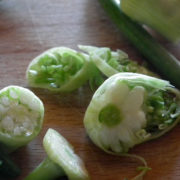
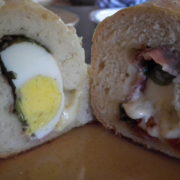

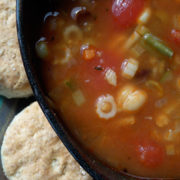
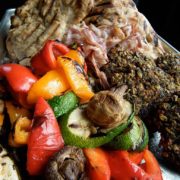




Leave a Reply
Want to join the discussion?Feel free to contribute!